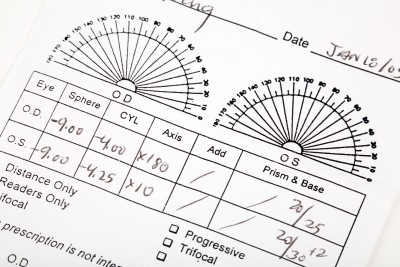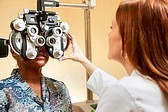Introduction
Wearing eye glasses has become the most convenient and safest option to correct poor eyesight or known as refractive errors. In addition to glasses, refractive errors can be corrected through the use of contact lenses and refractive surgery using laser radiation. For glasses wearers, are you sure that the power of your glasses is correct and in suitable for your eyes? The process of measuring the amount of refractive errors is called refraction. Glasses prescription is given to a person who has undergone refractive examination and diagnosed to have refractive error (Figure 1). The glasses prescription contains the corrective refractive power of glasses required for best vision. 
Figure 1: Sample Of Glasses Prescription.
However, the glasses power must be appropriate to the level of refractive error otherwise the wearer will feel uncomfortable using the glasses.
Signs And Symptoms Of Using The Wrongly Prescribed Glasses
The signs and symptoms that may be experienced as a result of wearing glasses with the wrong prescription are as below:
- Vision becomes blurred. This occurs when the glasses power is not sufficient or exceeds the refractive power.
- Pain or feeling pain around the eyes.
- Eyes feel tired and lethargic, especially after doing close work such as reading, using a computer or sewing.
- Headache and may also be accompanied with nausea.
- Double vision. (Figure 2)
- The image is distorted or tilted. (Figure 3)


Figure 2: Double Vision. Figure 3: Image Distortion.
How Could The Glasses Being Wrongly Prescribed?
The causes of getting the wrongly prescribed glasses are as follows:
- Refraction test done by unauthorized and uncertified eye care practitioner.
- Using improper refraction techniques and tools that do not correlate to patient’s eye problem. For example, pre-school and primary school children are examined by using computerized eye testing device or ‘autorefractometer’ solely without going thorough examination using retinoscope and undergone subjective refraction.
- Errors in the process of making glasses such as lens cutting and edging, lens centration is not properly measured and it may also happen where the lenses are switched over between left and right eye.
- Patient is having illness such as fever or flu which may associated with symptoms of watery eyes and runny nose during the refraction. These symptoms may interfere with the refraction findings.
- Patient is having common eye infection such as conjunctivitis which may cause blurred vision, red eyes, itchiness and watery, so it may interfere with the refraction findings.
- Patient is diabetic or having hypertension which is poorly controlled. This will cause the refractive power of the eyes become unstable due to fluctuating blood sugar level or blood pressure.
- Patient is having untreated underlying eye disorders such as dry eyes, cataracts or membrane growth near the cornea (pterygium).
How To Get The Best Corrective Power For Your Glasses?
Getting the most appropriate power for your glasses can be achieved by taking the following steps:
- Eye examination and refraction should be performed by a qualified optometrist or optician who is registered with the Malaysian Optical Council and has a valid annual practicing license.


Picture 4: Get Your Eyes Examined By A Certified Eye Care Professionals.
- Children usually require thorough examination due to their active focusing mechanism of the eye which may cause fluctuating power of the refractive error. Some children need to be referred to eye specialist clinic to undergo cycloplegic refraction where cycloplegic drops need to be instilled into the eye to relax the muscles of the eyes in order to obtain the most accurate refractive power.
- Individuals who undergo refractive assessment should not be having common illness such as cold, cough or fever.


Picture 5: Selecting The Appropriate Glasses For Children
- Patients with diabetes and hypertension must have good control of blood sugar levels and blood pressure before undergoing refraction to obtain a stable and accurate refractive power.
- Seek medical treatment for any underlying eye disorder before making eyeglasses. For example, cataract should be removed and replaced with lens implant before planning to make a pair of glasses with the correct power.
References
Notes:
- Buku Prosedur Operasi Standard – Penjagaan Pesakit Yang Mempunyai Ralat Refraksi (Kementerian Kesihatan Malaysia, 2009).
- Buku Prosedur Operasi Standard – Penjagaan Mata Primer.
(Kementerian Kesihatan Malaysia, 2009).
Pictures:
- http://3for1glassesoakville.ca/wp-content/uploads/2013/11/eyeglass-prescription.jpg
- http://www.healthline.com/hlcmsresource/images/topic_centers/EyeHealth/jpeg/194x105_Visual_disturbances.jpg
- http://phototechmag.com/wp-content/uploads/2012/10/lr6h.jpg
- http://images.inmagine.com/168nwm/blendimages/bld177/bld177192.jpg
- http://images.inmagine.com/168nwm/iris/bsip-024/ptg02698219.jpg
- http://images.cdn4.inmagine.com/168nwm/cultura/culs131/culs131671.jpg
- http://images.cdn5.inmagine.com/168nwm/juiceimages/juis033/juis033377.jpg
| Last Reviewed | : | 17 October 2016 |
| Writer | : | Pn. Nur Faiza Binti Ja’afar |
| Translator | : | Pn. Nur Faiza Binti Ja’afar |
| Accreditor | : | Pn. Nor’aini Binti Anuar |







